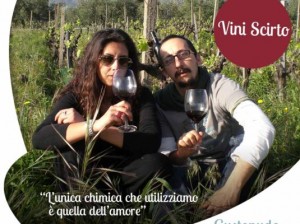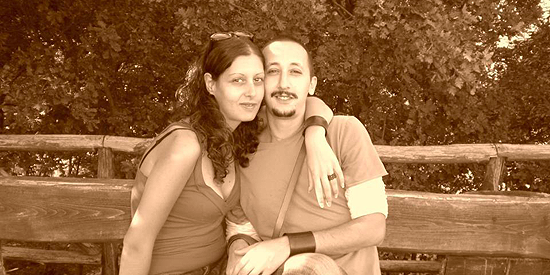
We soon got stuck into the pleasant task of tasting wines from the Etna region, starting with the whites. I finished up with 20 tasting notes, so a bottle must have arrived after the initial line up shown above. The tasting table picture was taken with permission from Valeria’s Facebook page and shows, left to right, Ben, my wife and me. The only thing missing from the picture, but not from the event, was the wonderful finger-food provided by Da Antonio, and the wine producers.
Towards the lunchtime, and I think about halfway through the tasting, producer representatives arrived to say hello to us and meet each other – owners and family members of the smaller producers, and winemakers and marketers from the larger ones. Left to right above are Mariarita Grasso, and Franco Calcagno with Valeria Càrasto.
And here is agronomist Giovanni Marletta with Alberto Falcone holding one of his bottles, and Patricia Tóth, winemaker at Planeta, in thoughtful discussion with Ben.
Finally, Ben with Agatino Failla, responsible for export sales at Benanti, and Valeria Franco and Giuseppe Scirto. We also met Antonino Destro, Peter Wiegner, and Irene Badalà, but sadly they will have to remain pictureless, and is as far as I can tell Irene does not have a website.
As ever, please do not take my tasting notes too seriously – they show my impressions on the day, no more no less – I hate to be seen as a judge of wines, but also feel I want to communicate my impressions. Looking back on my notes I see that there are a lot more high scores than usual, which is measure of how I enjoyed the day, but which I fear might be a bit unfair to wines elsewhere in my blog. The prices are approximate UK retail, or my best guess in the cases where they are not available over here.
Saxanigra, Vino Spumante, Metodo Classico, Brut, Destro, 2010, 12.0%, £20.00
This is 100% Nerello Mascalese, with 36 months on lees. Pale greenish straw. Very persistent surface foam, whose appearance reminded me of Asti. But appearance was the only similarity to Asti. This was fresh, dry, and had high acidity. Intense minerality and fruit. I think I would probably drink this now, but it could have aging potential ****
Isolonuda, Etna Bianco DOC, Destro, 2013, 12.5%, £13.00
Carricante, with some Carraratto. Pale straw. Intense fruit, and with a distinctive spice. Clove perhaps? Medium acidity. Dry, intense, viscous. Excellent length. Drink now****
Mari, di Ripiddu, Etna Bianco DOC, Filippo Grasso, 2011, 12.5%, £13.00
Carricante, with some Carraratto, 50% from Milo. Medium gold. Don’t get a lot on the nose. Medium acidity. Dry, with citrus fruit. Thought I detected oak, but there is none! Excellent length. Drink now ****
Eruzione 1614, DOC, Sicilia Planeta, 2013, 14.0%, £14.00
Carricante and 5% Riesling. Medium gold. Again, that spicy note that could be clove. Medium acidity. A little off-dry I think? Citrus. Excellent length. Drink now ***
Dayini, Bianco, Etna DOC, Terre di Trente 2012, 12.5%, £18.00
Carricante and Minnelo. Medium gold. Reductive and farmyard – but in a good way. Medium acid. Dry, elegant, complex and subtle. Drink now *****
Wiegner, Elisena, Sicilia IGT, 2011, 13.0%, £15.00
Fiano. Medium gold. Dumb on the nose. Medium acidity. Dry, elegant, some complexity. Something about this wine that I find difficult to characterise. Drink now *****
Quantico, Etna Bianco DOP, Giulemi, 2012, 13.5%, £25.00
Carricante and Cateratto. Biodynamic, natural, and I’ve heard they do weird stuff with electromagnetism in the vineyards (which I am sure someone else told me was bad for cosmic energy, but what do I know). Medium gold. Nose is complex and had a sweet nature. Medium high acidity. Definitely dry on the palate. Hugely intense. Apples. Drink now *****
Eruzione 1614, Nerello Mascelese, Sicilia IGT, Planeta, 2011, 13.5%, £14.00
Pale ruby garnet. Slightly reductive red fruit. Medium low acid. Medium low tannin. Drink now **
Treterre, Sicilia IGT, Rosso, Wiegner, 2009, 14.0%, £15.00
Nerello Mascalese. Medium garnet. Rasiny red fruit. Medium high acid. Medium tannin. Raisiny, but fresh. Intense. Drink now ****
Arcuria, Etna Rosso DOC, Calcagno, 2011, 14.0%, £17.00
Arcuria is the Contrada name. 2010 was the drier vintage in this Contrada, but 2011 is generally better. Medium garnet. Dumb. Spicy red fruit. Medium high acid. Medium tannin. Good sweet intense fruit. Drink now or keep ****
Arcuria, Etna Rosso DOC, Calcagno, 2010, 13.5%, £17.00
More tawny than the 2011. More intense, and spicier, but otherwise quite similar. Good intense fruit. Drink now or keep *****
Capu, Chiurma, di Ripiddu, Etna Rosso DOC, Calderara Sottano, Filippo Grasso, 2011, 14.0%, £18.00
Intense garnet. Smoky. Reductive. Medium acidity. Medium high tannin. Big, powerful and intense. Sweet fruit. Needs several years *****
Etna Rosso DOC, Azienda Agricola Irene Badalà, 2012, 14.5%, £20.00
From a 3ha vineyard. The wine is made at Terre Nere. Intense ruby garnet. Intense sweet perfumed fruit. Medium high acid. High tannin. As nose. Very attractive wine. Needs more time ******
A’Culonna, Scirto, Etna Rosso DOC, 2010, 14.5%, £30.00
Medium pale garnet. Fresh red fruit. Medium acid. Medium tannin. As nose. Delicate and elegant. Another great wine. Drink now or keep ******
Nerello Mascalese, Sicilia IGT, Terre di Trente, 2008, 14.0%, £21.00
Medium pale garnet. Reductive. Medium acidity. Medium high tannin. Metallic finish. Maybe will come round with time, but I find this difficult to like now **
Quantico, Etna Rosso DOP, Giulemi, 2012, 13.0%, £25.00
Pale garnet. Gentle nose with blackcurrant. Medium high acidity. Medium low tannin. Excellent length. Drink now, but no hurry *****
Aitho, Etna Rosso DOC, Azienda Falcone , 2012, 13.5%, £15.00
3ha South-West of Etna, and high altitude vineyard. Medium pale garnet. Reductive, perhaps. Fresh aromatic fruit. Medium high acid. Medium high tannin. Needs more time***
Rosso di Gulfa, Etna Rosso DOC, Feudo di Gulfa, 2011, 14.0%, £25.00
South-West of Etna. Medium pale ruby garnet. Intense fresh fruit. Medium high acid. Medium tannin. A little raisiny, but still refreshing. Excellent length. Spice. Good now, but will improve *****
Serra delle Contessa, Etna Rosso DOC, Benanti, 2004, 14.0%, £31.00
Prephylloxera. Nerello Mascelese and approx 20% Nerello Cappuchio. Medium pale garnet. Intense, mature, complex, aromatic. Medium high acid. Medium high tannin. Intense. Great now, but still scope for improvement ******
Pietra Marina, Etna Bianco Superiore DOC, Benanti, 2009, 12.5%, £31.00
Pale greenish gold. Complex, and not too intense on the nose. Medium acidity. Dry. Intense, and complex in ways I find difficult to describe. Good now, but will keep for several more years ******
For those that know Benanti maybe it is no great surprise that I liked their wines so much, especially considering they had the advantage of a fair amount of bottle age over the others at the tasting. But I was really impressed by them, even though they were numbers 19 and 20 of a 20 wine tasting. The white was even tasted “out of order”, after the reds.
My other two favourites (given all the caveats already expressed) were a couple of wines less familiar to UK drinkers. They are pictured below to help you recognise them should you get a buying opportunity. The Scirto A’Culonna was difficult for me to adequately describe, but had a quiet elegance that I really liked. While the Irene Badalà was very different, being very astringent and with intense and good quality fruit. I really didn’t think the Badalà was ready for drinking now, but I took a bottle home with me and look forward to trying it again in several years time.
After my Etna trip, and this tasting in particular, I certainly understand Etna wines a lot better than before, but I still don’t think I have a great handle on the major grape varieties of Carricante and Nerello Mascelese. Indeed I am beginning to doubt there is much of a handle to grasp. I view them both as being like Chardonnay, in the sense that they are good quality, but seem to be able to adopt a broad variety of styles, but do not have easily recognised aromatics. The only style that I have not encountered in Etna wine is over-ripe flabbiness – they all have good structure, even reds with raisiny notes. Where the comparison with Chardonnay breaks down is in the underlying cause of style variation. That is, I suspect that the Etna varieties are more similar to Riesling and Pinot Noir in their ability to express terroir, if not the distinctiveness of their aromas. I would be interested to hear other views on that subject. I have certainly seen Nerello Mascelese aromatics compared to Pinot Noir and Nebbiolo, but I am personally not convinced.
Finally, I’d like to say a big thank you to Ben and Valeria of Etna Wine Lab. They are great people, very knowledgeable, and responded very positively and flexibly to my requests for help to become better acquainted with Etna wines.


















